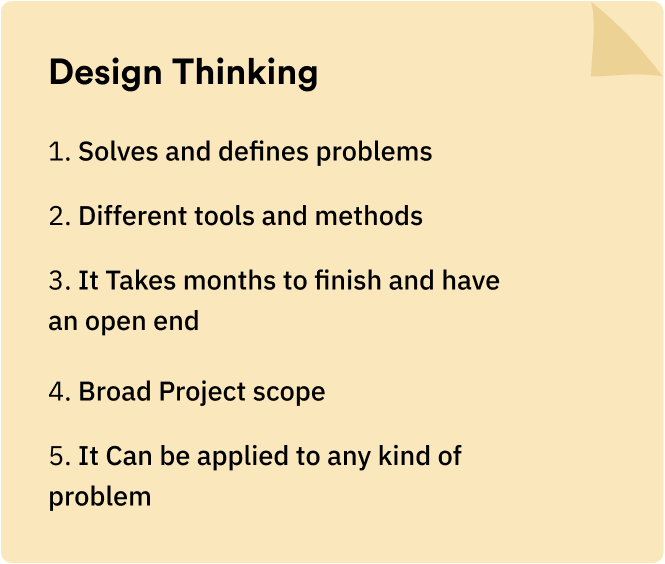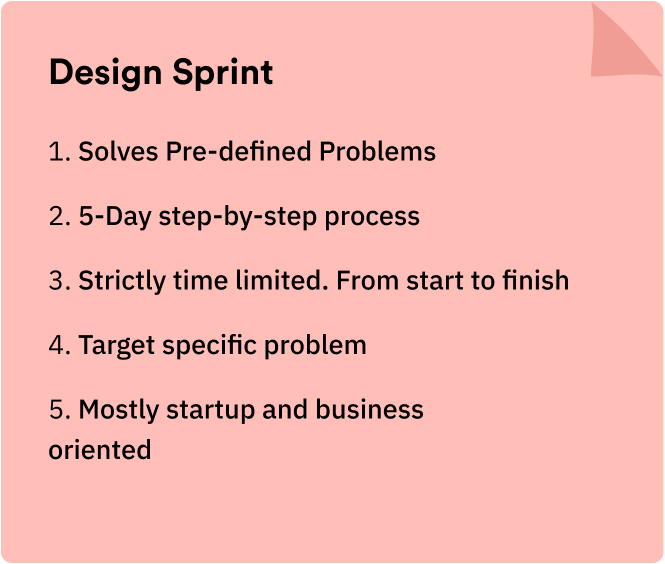Demystifying Design Sprint and Design Thinking
February 27, 2023 | Read Time : 3 mins
Table of Contents
A lot has been said and written about Design Thinking since it became popular at Stanford University in the 1980s and was brought to the corporate sector a decade later by the creative firm IDEO. Design Thinking is best described as a human-centred design methodology incorporating empathy and creativity to create standout solutions. Product teams may generate innovations for the worldwide market with the support of this problem-solving process.
The steps of the Design Thinking process take you from defining the problem to identifying the best feasible solution:
- The Empathy phase: is when you listen to your target audience’s requirements to comprehend their point of view.
- The Define phase: is when you utilise the user insights to understand the problem and ensure your solution solves the right challenge.
- Ideation stage: You let your imagination run wild at this phase and come up with potential problems to solve.
- Prototyping: You will create a working prototype to depict your idea during this step.
- Testing: You test your prototype to find out what works and doesn’t.
You put your prototype to the test to see what functions well and what doesn’t. You may repeat the ideation, prototype, and testing stages until you find a practical and creative solution to your problem.
Design Thinking, which focuses on listening to users, understanding their needs, and applying that knowledge to create solutions for complex problems, has proven to be a time-tested strategy. In actuality, the Design Thinking methodology served as the foundation for developing the new design sprint methodology.
What is Design Sprint?
A Design Sprint is a five-day process based on Design Thinking methodology for cross-functional teams with the goal of validating a business concept, design, or product overhaul.
Design Sprint first appeared at Google Venture, which invests Google money into startups, in 2010. In fact, this is when the origination best captures the essence and primary goal of the concept.
The design sprint process is very intense but interactive. It consists of five main stages:
Map
This is the stage where you set your sprint goals. Collect all accessible data on the problem statement, customer profiles, and other relevant information from previous rounds of User Research.
Sketch
The ideation phase in the Design Sprint approach is frequently carried out as a sketching workshop. You develop assumptions and hypotheses during the session based on the information gathered.
Decide
Team members vote on the best idea. It can be accomplished through open debate or by silent voting.
Prototype
Create a model prototype of your solution. Choose what you’ll develop depending on your team’s skill sets and
time constraints.
Test
Put your hypotheses to the test with real users. Check to see whether the proposed solution works.
Following these five main stages, users and stakeholders examine the findings. Identify areas that may be improved for future iteration or release.
What do Design Thinking and Design Sprint have in common?
Design Thinking is the main component in a process called a “Design Sprint,” which also incorporates lessons from other methodologies like Agile, Lean Startup, and Customer Development. Saying that Design Sprints are only one method of applying Design Thinking is inaccurate.
The Design Sprint is a highly collaborative method for ideation, creativity, and problem-solving, much to Design Thinking. Cross-functional teams and aid use both approaches in providing answers to important problems through design, fast prototyping, testing, and immediate user feedback.
Differences between Design Sprints and Design Thinking
The primary distinction is that Design Sprints address specific problems, whereas Design Thinking is used to tackle general ones. Design Sprints are a technique for building a prototype with less time and money, whereas Design Thinking is more of an overarching philosophy for addressing problem-solving. Let’s compare these two methods:


With so many similarities and differences, it cannot be easy to decide which one to use for your project.
When should Design Thinking be used instead of a Design Sprint?
- The goal is to grasp the distinction between these two methods and to use Design Sprints or Design Thinking where they are most successful.
- The time when you most require Design Thinking is when you see a chance to improve people’s lives. This approach focuses on unconventional thinking to deliver a truly innovative solution.
- A Design Sprint is a scaled-down, rapid version of the Design Thinking process. Some people even refer to it as a Design Thinking Sprint. It is most effective when your problem or concept is well-defined. The Design Sprint is very focused on business. It successfully responds to a simple business query: “Will this idea succeed in the marketplace?”
- Design Sprints are extremely helpful when you have little time or money since they allow you to test your idea in
only one week. - Design Sprints are also very effective when you obtain some market insights in your niche on the spur of the moment and want to see whether they apply to your product or when you are faced with a challenge and must make a choice.
- Both Design Thinking and Design Sprint may be useful, especially when working on a big project. When these methods are combined, the results are even more powerful.






